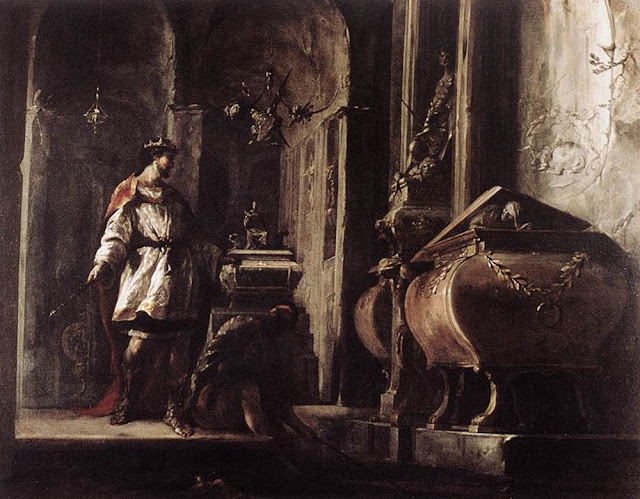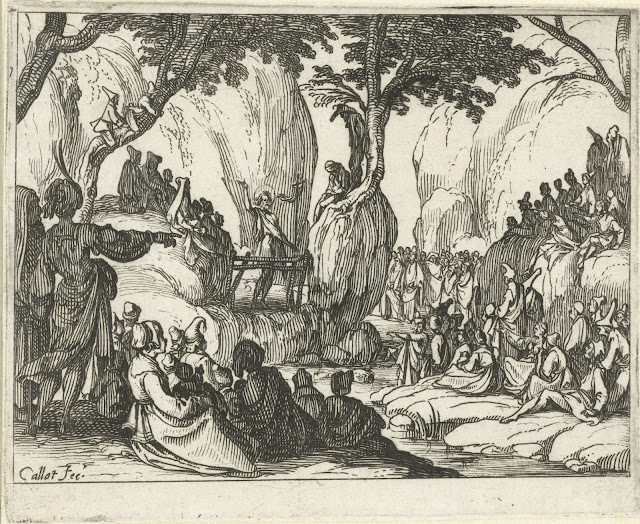 |
| Johann Heinrich Schönfeld Allegory of Time (Chronos & Eros) 1630s Palazzo Barberini, Rome |
 |
| Johann Heinrich Schönfeld Saul & Endor the Magus 1630s Palazzo Barberini, Rome |
At Palazzo Barberini in Rome several years ago the pair of small paintings above introduced me to the work of Johann Heinrich Schönfeld (1609-1684). The Barberini catalogue entry by Rossella Vodret offers a certain amount of background about this distinctive and little-known artist –
"After an initial artistic training in southern Germany, Schönfeld came to Rome in 1633. There he joined the Schildershent, the informal band of Flemish, Dutch and German painters in Rome. From a stylistic point of view, however, he was more influenced by his exposure to the neo-Venetian, classical experience of Poussin and his circle. Moving from Rome to Naples, where he stayed from 1638-39 to 1648, Schönfeld was an important vehicle for the transfer of this Roman style to that city. In the art world of Naples, where the hierarchial division between the genres was more pronounced, he specialized in painting subjects from ancient history and mythology. It was his aptitude in this area that drew the attention of Flavio Chigi, whom he met during the course of his second stay in Rome. Chigi, the nephew of Pope Alexander VII, preferred to collect paintings with obscure allegorical or necromantic symbolism. Schönfeld's clear and subtle colors, the vibrant and nervous brushstrokes, and the strong, direct light render his figures evanescent and almost unstable. These elegant and elongated figures, derived from engravings by Callot, are placed in strongly classical settings that are similar to contemporary theatrical scenes."
Bellow, one of the Mannerist prints by Jacques Callot (1592-1635) cited in the Barberini catalogue as the source of Schönfeld's "elongated figures." Callot was French by birth but spent much of his career in Italy. He was the most successful print-maker of his generation.
 |
| Jacques Callot John the Baptist Preaching 1634-35 etching Rijksmuseum |
 |
| Johann Heinrich Schönfeld Alexander the Great before the Tomb of Achilles 1630s Palazzo Barberini, Rome |
Schönfeld's surviving paintings are scattered throughout Europe. I was not able to locate any in United States collections. In 2010, to honor the 400th anniversary of the painter's birth, a retrospective of his work was staged in Augsburg, the city where Schönfeld settled after eighteen years in Italy, and the city where he died.
| Johann Heinrich Schönfeld Artist Sketching Roman Ruins c. 1634-35 Deutsche Barockgalerie, Augsburg |
 |
| Johann Heinrich Schönfeld Simon's Revenge on the Philistines 1633-34 Kunsthistorisches Museum, Vienna |
 |
| Johann Heinrich Schönfeld Roman Carpriccio c. 1635 Private collection |
 |
| Johann heinrich Schönfeld Die Plünderer c. 1635 Braith-Mali Museum, Germany |
 |
| Johann Heinrich Schönfeld Rape of the Sabine Women 1630s Hermitage, St. Petersburg |
 |
| Johann Heinrich Schönfeld Saint Cyriakus c. 1640 Private collection |
 |
| Johann Heinrich Schönfeld Scythians at the Tomb of Ovid c. 1640 Museum of Fine Arts, Budapest |
 |
| Johann Heinrich Schönfeld Triumph of Venus c. 1640-45 Gamaldegalerie, Berlin |
 |
| Johann Heinrich Schönfeld Adoration of the Holy Trinity c. 1647-49 Louvre |
 |
| Johann Heinrich Schönfeld Atalanta & Hippomenes 1650s Brukenthal Museum, Romania |
 |
| Johann Heinrich Schönfeld The Marriage Feast at Cana 1670s Hermitage, St. Petersburg |








































